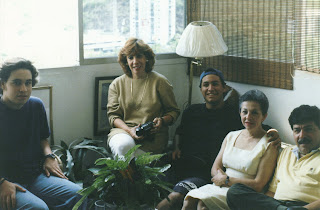 |
| We all need some... education |
My primary concern in this decision-making process at 16
or 17 years of age was the lack of overall professional support and advice. My
high school guidance counsellor, Mr. Robert Piper, was a great person, but he
was also from a different generation. He had suggested that not everyone had to
go to university. Many of his peers had not even completed high school, which
is a no-no for my generation. I had a pretty good idea that I wanted to study
Political Science and, afterwards, join the Canadian public service in hopes of
pursuing a career as a political analyst/researcher. I developed great admiration
not only for my father, but his outstanding colleagues and the work they did
for Canada. Many of our fellow compatriots back home did not appreciate the
level of sacrifice and selflessness endured during their life of service. This
made no difference to me as a career choice, as there was no higher honour in
my mind than serving a country that had given me so much.
Maybe the fact that I was part of an expatriate population
– although I doubt this was the case – but there was really no structured guidance
at all in the process. The concept behind this next step in your academic life
or career progression is that, if you apply yourself, you can achieve anything
you want. This is a perfect strategy if you are in a situation where you can
influence the entire environment you live in - this is usually not the way the
world turns. At that point, I would have appreciated some sort of aptitude test,
which could help me to identify my skills, my interests and what careers would
be in demand after 4 or 5 years in the labour market. Not everyone can be a supreme court judge, a powerful CEO in the banking sector, head of a medical board or Prime
Minister. Unfortunately, most education systems seem to spoon-feed students,
taking them by the hand without letting them think for themselves independently.
Eventually, however, the firm high school hand lets go. Young students are
pushed away, told that they are on their own now and have to make their own
decisions. Masters of their own destiny, so to speak. There is no smooth
transition, even less in North American education systems.
The MacLean’s magazine’s Guide to Canadian Universities
was a key factor for me in deciding which universities I wanted to attend. It
was a great resource at the time, ranking our fine institutions by province,
faculty, grades, scholarships, number of students and other important factors.
Afterwards, I created a shortlist of four schools based on the criteria
established by the OUAC (Ontario University Application Centre). This was a
great introduction to the wonderful world of intrusive but ineffective Canadian
bureaucracy – I had to pay for the service, but was restricted to 4
universities. We were all born to be bookkeepers, I suppose. My final four were
Carleton University and the University of Ottawa, both in the nation’s capital,
Trent University and the University of Western Ontario. I am sure you can all
take a wild guess – and you will probably be right - as to why I applied to the
last one after having read these blog entries. The Canadian Embassy also had
some literature, although somewhat outdated. I am sure many of my peers had
gone through the same challenges in making up their minds.
 |
| The evolution of the OUAC application |
As the nature of my friendships was quite
international, many of us knew the next step would lead to separating the
group. This may be why we avoided talking about this process in our circle of
trust. I never really thought about their grades, their futures or what they
wanted to do after graduation. I just imagined we would all return to where we
came from, or others would venture into a new land. We focussed on enjoying
today, the moments that made our lives worthwhile and a veritable click. On my
end, I was successful on separating my schoolwork, ensuring I would not have
any trouble getting into one of the four schools to which I had applied, and
continued belting out some mad swings on the softball field. Tomorrow was a
long way away.





